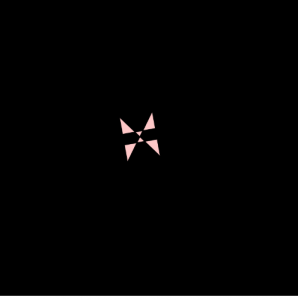//Robert Oh
//Section C
//rhoh@andrew.cmu.edu
//Project-07-Curves
//assigning variables
var nPoints = 100;
var angle1 = 0;
var adj1 = 10;
var angle2 = 0;
var adj2 = 0;
var angle3 = 0;
var adj3 = 0;
function setup() {
createCanvas(400, 400);
frameRate(60);
}
function draw() {
background(0);
//drawing the white circle
ellipse(mouseX, mouseY, 170, 170);
//drawing the red Quadrifolium
push();
fill(255, 0, 0);
translate(mouseX, mouseY + 45);
rotate(radians(angle1));
drawQuadrifolium();
angle1 = (angle1 + adj1) % 360;
pop();
//drawing the green Quadrifolium
push();
fill(0, 255, 0);
translate(mouseX + 39, mouseY - 20);
rotate(radians(angle2));
drawQuadrifolium();
angle2 = (angle2 + adj2) % 360;
pop();
//drawing the blue Quadrifolium
push();
fill(0, 0, 255);
translate(mouseX - 39, mouseY - 20);
rotate(radians(angle3));
drawQuadrifolium();
angle3 = (angle3 + adj3) % 360;
pop();
//adjusting speed of rotation for only blue and green Quadrifoliums
adj2 = (15 * (mouseX / width)) + (15 * (mouseY / height));
adj3 = (15 * (width - mouseX) / width) + (15 * (width - mouseY) / height);
}
//formula taken from: http://mathworld.wolfram.com/Quadrifolium.html
function drawQuadrifolium() {
var a = 40;
beginShape();
for (var i = 0; i < nPoints; i++) {
var t = map(i, 0, nPoints, 0, TWO_PI);
r = a * sin(2 * t);
x = r * cos(t);
y = r * sin(t);
vertex(x, y);
}
endShape(CLOSE);
}
When I first started this assignment, I was looking around for inspiration. One morning, when I started shaving with my electric razor, I realized that my blades were in the shape similar to that of a quadrifolium. Thus, I created the three quadrifoliums in the same shape as my razor. I adjusted the speed of the top two “razors” to speed up/slow down if they are near the edges of the canvas.

![[OLD FALL 2018] 15-104 • Introduction to Computing for Creative Practice](wp-content/uploads/2020/08/stop-banner.png)